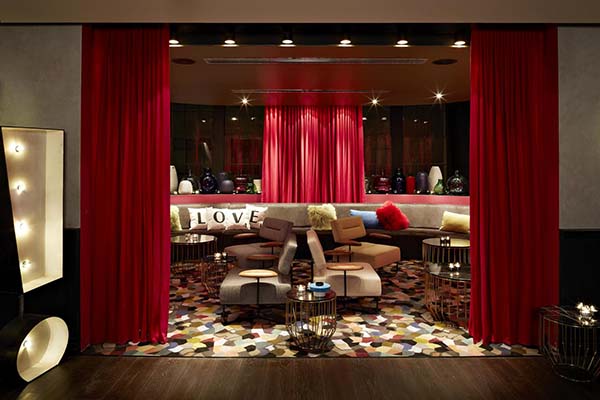QT Sydney illustrates an ideal mix of history, location and contemporary design. Two of the city’s most iconic buildings have been restored to their former glory, capturing the romance of the era in which they were built, while creating a new landmark for the city. The revitalisation of the heritage-listed State Theatre and Gowings department store offers excitement, elegance and style in an ideal location surrounded by the best of the city – including the historic Rocks district, world famous beaches and endless opportunities for wining, dining and shopping.
Although the two buildings were both completed in the late 1920s, stylistically they are very different. The State Theatre is one of only two surviving theatres in Sydney that are designed by Henry E. White and John Eberson, and mixes eclectic elements of Gothic, Italian and art deco design. The Gowings department store, designed by Crawford H. Mackeller and constructed in 1929, has a vast and open layout – big windows, high ceilings, wide corridors and sandstone cladding. The conversion of the upper floors into a bright and chic boutique hotel experience did not affect the State Theatre, or the lower retail levels of the Gowings building, which have remained unchanged.
Guests enter via the lobby of the State Theatre on the first floor, where the building’s theatrical past can be felt, with stage lights casting a glow over the reception and draping, heavy stage curtains leading guests into the building. Throughout both buildings, historic elements have been conserved and enhanced, including original timber floors, retail showcases in the hotel entry foyer, original stone cladding and gargoyles that grace the facade. Any traces of remaining history have been given a fresh and modern spin with colours and decor as rich and colorful as the buildings’ history – such as royal blue, magenta and yellow; statement furnishings; and geometric patterns on the ceilings and floors.
Over the years, Sydneysiders have grown attached to these buildings, therefore it was a priority of the developers that the historic street level activities of theatre and retail be maintained. QT Sydney’s Gowings Bar & Grill, operated by one of the city’s culinary greats, as well as the Gilt Lounge attract the who’s who of the fashion and entertainment industries. While the lively lobby, linked to all the action on Market Street, creates atmosphere as guests arrive with the streetside barista Parlour Lane Roasters.
Inspired by an energetic collection of original artworks and cutting edge graphics, Nic Graham delivers a plethora of stunning architectural features and interior design in the public spaces of QT Sydney.
After making a name for himself with the vibrant and cool beach club-style QT resort in Port Douglas and QT Gold Coast, Graham has shaped QT Sydney’s public spaces by reworking the historical features of the hotel’s façade and crafting articulate, vibrant interiors.
Significant historic fittings and fixtures have been worked by Graham to highlight the historical design aesthetic of the space while a huge LED display wall of digital art will be a feature of the hotel’s reception area. Eclectic and dynamic pieces have been selected by Graham to create a visual, design experience for guests.
spaQ has also been ingeniously designed by Graham. Using a palate of earthy tones and vibrant accents, furnishings and décor depict the heritage of QT Sydney’s location. The Spa featurse six treatment rooms and a Hammam which adopts a vintage-cool persona, providing a contemporary social space for guests to relax and unwind.
PointOfView created the lighting for the entire hotel, restaurants and bars.
The lighting is integral to a design vocabulary that has been attracting much attention. “QT is a small chain, and we worked on QT Gold Coast too” says Mark Elliott, director of POV Lighting. “They were both great projects to work on, and we’re very happy that QT Sydney is such a success with both foreigners and Sydneysiders.”
“With every project we work on, we try to push every dollar of the budget to deliver something special. This project had aspirations to be the most talked about hospitality project in Sydney for years,” said Elliott, who has lit some of London’s leading restaurants and bars including Nobu at the Berkeley. “There were challenges in that it’s a heritage building too.”
In the public spaces, interior designer Nic Graham created a strong aesthetic, so the goal of the lighting was to complement that. “We tried to enhance the eclectic colours, materials and textures, so that guests can bathe within pockets of light and shade. We avoided unwanted architectural lighting projecting into the space, and supported Nic Graham’s team with technical information wherever needed.” said Elliott.
The hotel set out to have an international feel, and compete with the best that New York has to offer. The lighting needed to create drama and an experience that would genuinely delight educated travelers.
POV used a high quality lighting control system and retained some use of halogen lighting, which provides an ambience that even now cannot be matched by LEDs. They chose to focus on feature elements rather than uniform washes of light. Integrated lighting played a huge role in the Bar and Restaurant, where the hamper over the bar is turned into a focal chandelier, and LED strips illuminate the bottles within. The double height wine wall is washed with light from within, creating a central focus and drawing the eye to the upper bar.
Custom designed fixtures were designed to complement the interior design, driven by G+A with technical assistance from the POV team.
“The part that you don’t notice, is usually the part we spent most time over, and probably has the biggest effect on the lighting as a whole!” said Mark Elliott. “When lighting is really successful, people don’t notice it, they just respond very warmly to a space.”





